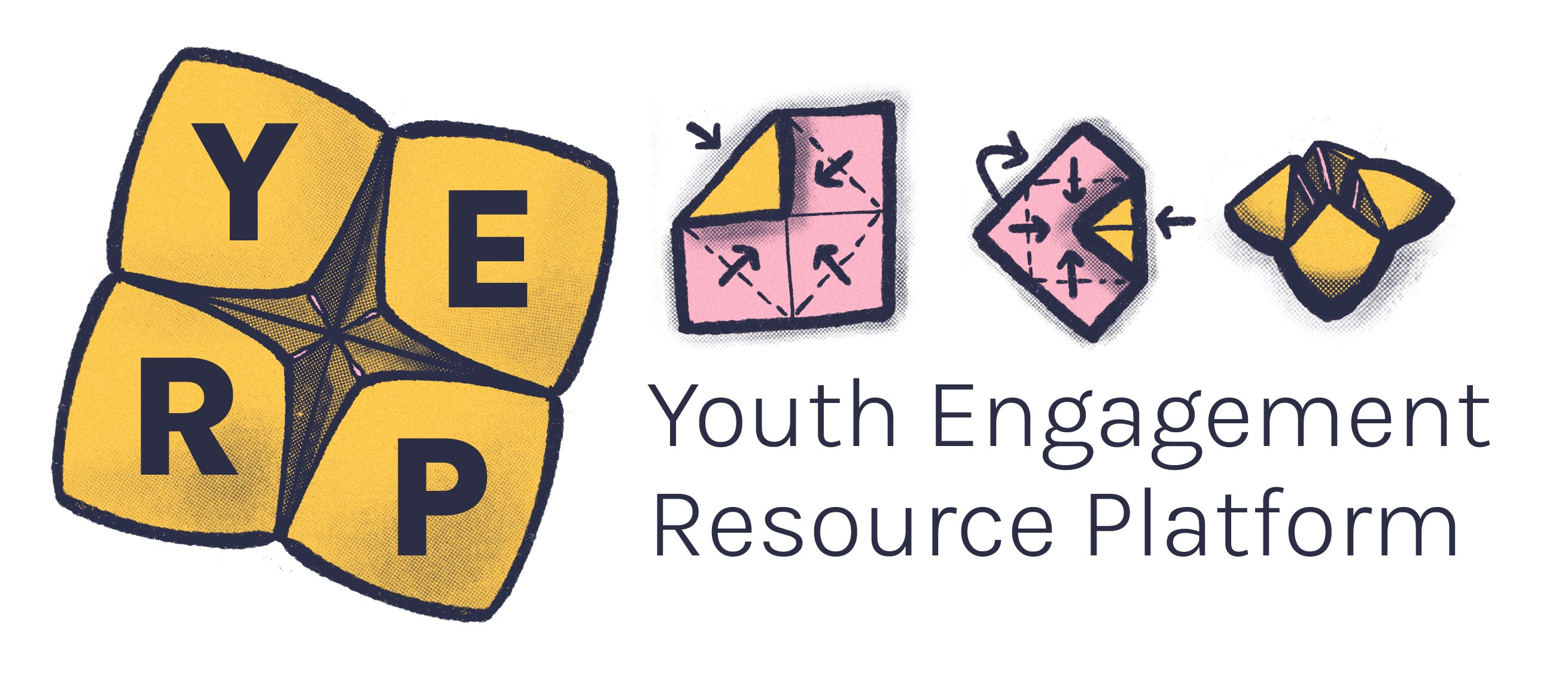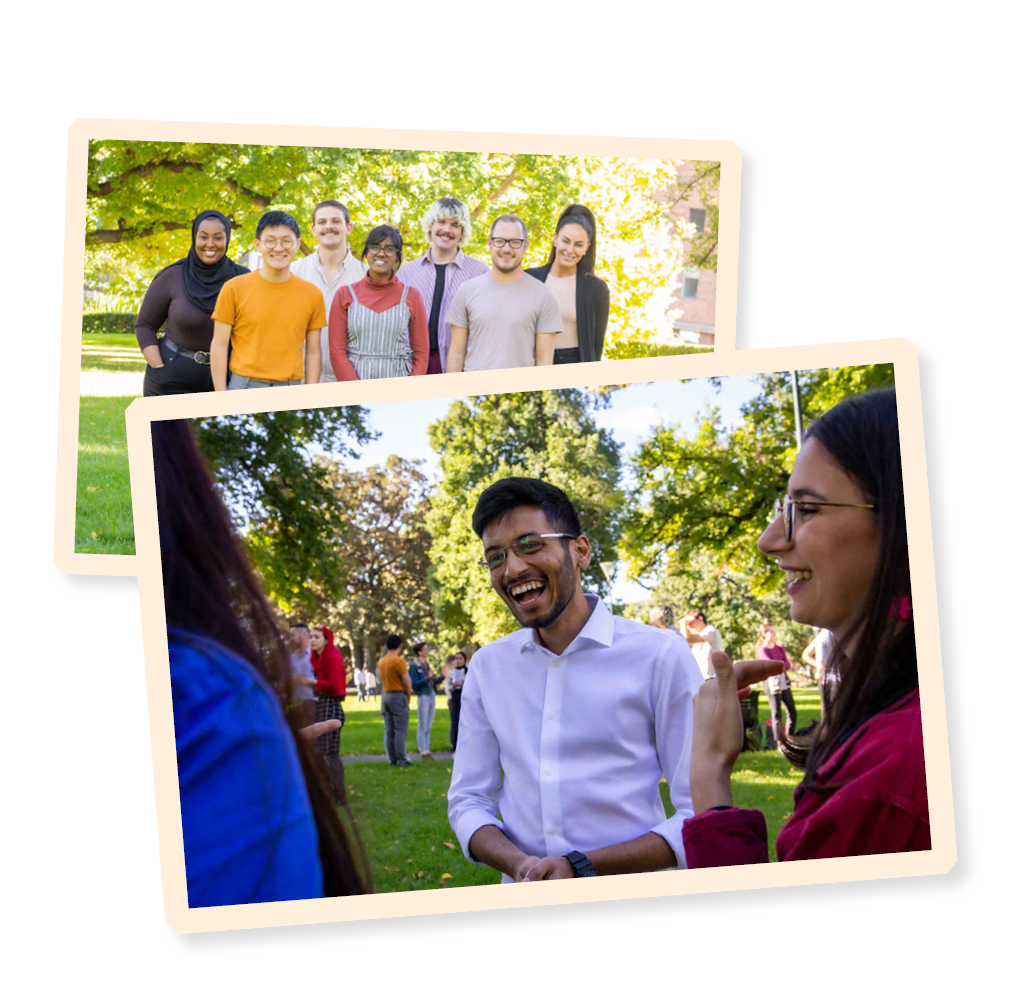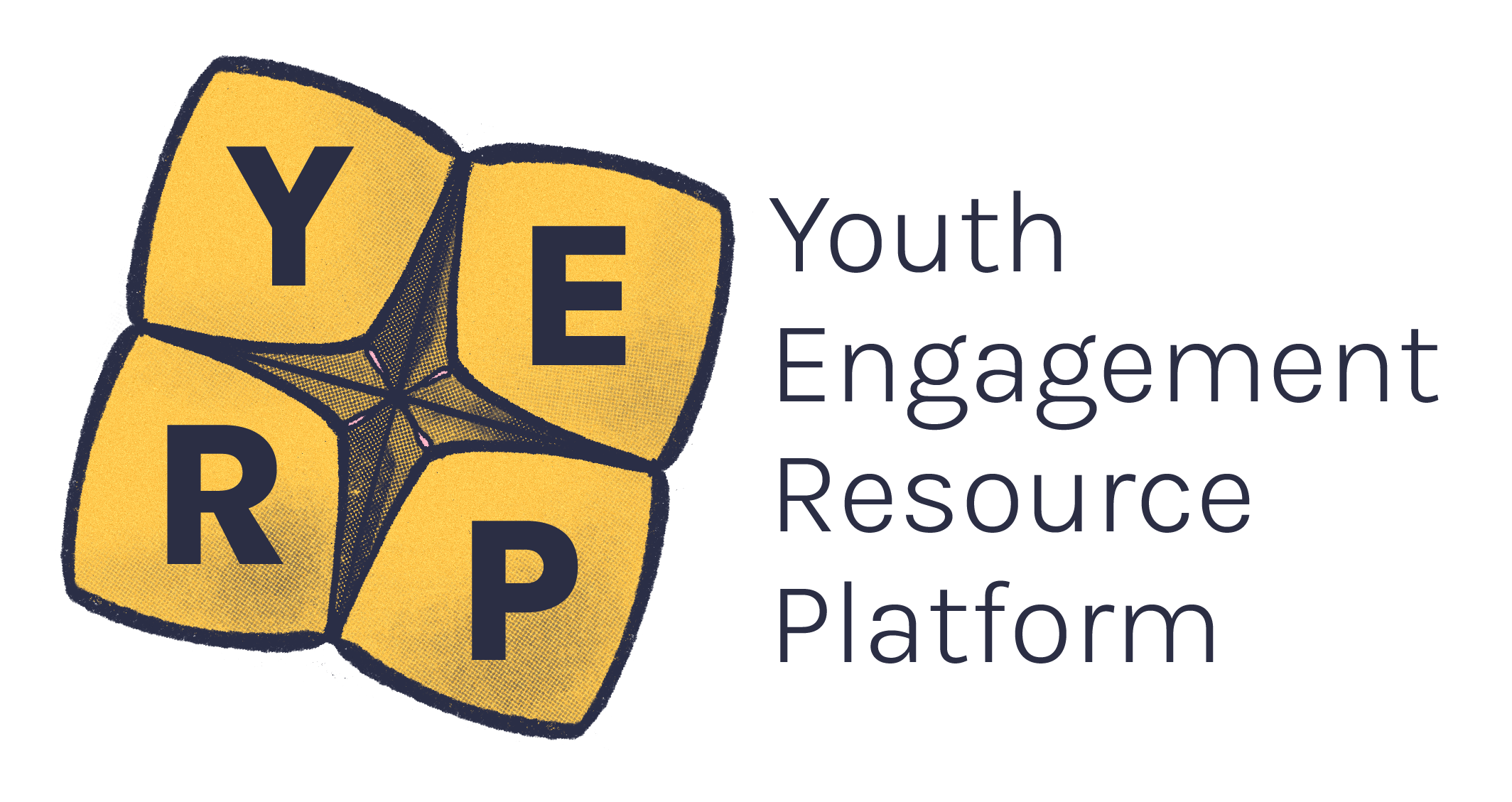Youth participation is actively involving young people (usually those aged 12-25) in decision-making processes. The concept relates to ideas of citizenship and how young people can be actively involved in society.
As a practice, youth participation involves young people in activities, organisations, government and community structures, and engages them on issues that directly affect them. It is all about meaningful opportunities for young people, valuing their contributions and empowering them to help shape our world.
Participation is a human right. It is also a Something that reduces the likelihood of negative impact.protective factor. According to Standard 3 of the Victorian Child Safe Standards, “Children and young people are empowered about their rights, participate in decisions affecting them and are taken seriously.”
Empowerment: young people having greater control over their lives through access to support and pathways to opportunities that make change to their life.
Purposeful engagement: young people taking on valued roles, addressing issues that are relevant to them, and influencing real and meaningful outcomes.
Inclusiveness: ensuring all young people are able to participate, regardless of background, lived experience, culture, where they live, their gender, disability status or sexuality.
A drawing of two large hands cupped around the planet Earth. There is a group of five young people climbing over the large hands. Two are marching with megaphones and signs, one is helping another climb from the bottom hand to the top hand. One person is sitting on the bottom hand smiling upwards.
Illustration by Minuki Merissa Satharasinghe.
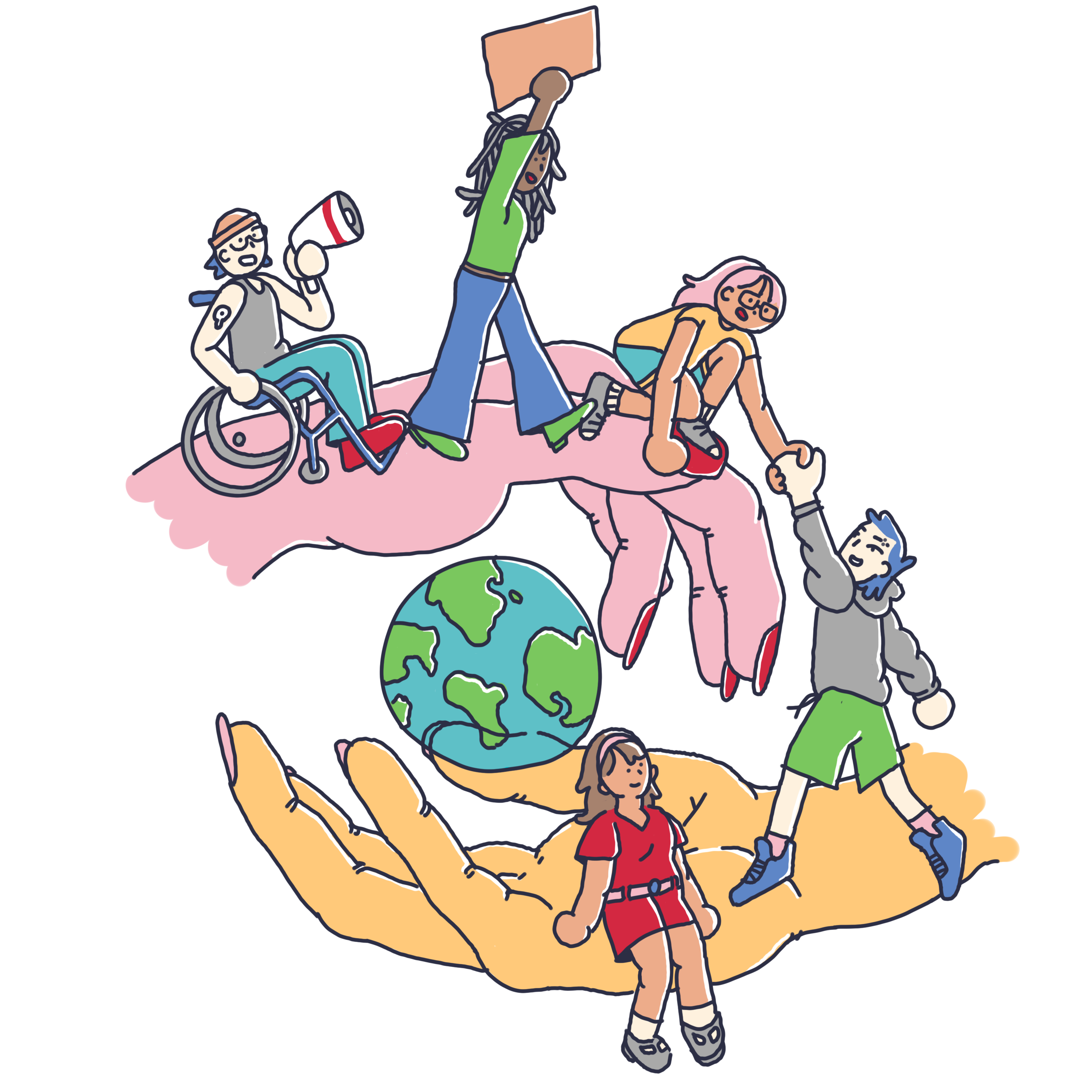
Young people may be asked to participate in consultations about their housing situation to contribute to housing policy reform.
Many young people across regional Victoria are concerned about the public transport system. When the Victorian Parliamentary Inquiry into the Use of School Buses in Rural and Regional Victoria launched, many young people sent recommendations and contributed to submissions.
The School Strike 4 Climate Australia movement is led by school students across Australia who want to fight for climate justice.
Many local governments have youth committees or councils that young people can take part in.
Being involved in all levels of government and any organisation that isn’t youth-led. Many organisations (including YACVic) have dedicated positions for young people within governance structures.
These empower young people to take on varied levels of responsibility to make change in areas they care about.
Australian Youth Climate Coalition, Seed Mob, Oaktree and UN Youth are all examples of organisations that put young people in positions of power.
Think about youth participation as ongoing, common practice – it shouldn’t be Doing something (often the bare minimum) to tick a box and avoid criticism, rather than doing something more meaningful.tokenistic, or something to be done as a once-off.
It should support young people to act, make their own decisions and advocate for themselves.
Without youth participation, young people are passive ‘clients’ with decisions being made for them rather than actively participating in their own lives.
Accessibility can often be a barrier for young people. If a space, event or meeting is not accessible, then young people may be unable to participate fully and effectively, or at all. It is crucial to make spaces, events, meetings and programs etc. as accessible as possible.
Some accessibility tips are:
-
Having gender neutral toilets
-
Ensuring spaces can accommodate mobility devices
-
Using plain language in verbal and written communication
-
Using captions and providing interpreters if necessary
-
Limiting fragrance
-
Sending information in advance so people can feel prepared
This list is not exhaustive. It’s important to ask young people for their access needs so you can make their experience more accessible.
It is also best practice to make spaces, events and programs inclusive regardless of who is there.
Accessibility can also be about the unique contexts of young people’s lives. For example, they may not have access to a car, or they may work casually so they need to juggle different shift times and a changing roster.
Allowing room for flexibility accounts for demands in other areas of their lives, and creates an environment they’re more likely to succeed in.
For more on accessibility head to the diversity and inclusion section.
Young people come from many different backgrounds and cultures and sometimes this means spaces are not safe for them.
This may be due to a lack of understanding and competency around their lived experiences, and ways to support them. This can result in young people feeling uncomfortable, or that they need to be a ‘spokesperson’ for their group or identity, and the burden of educating the people around them falls on the young person.
Young people also report the burden of assumptions and biases that many young people from First Nations communities and those with refugee and/or migrant backgrounds face.
Workers should be proactive in educating themselves about the specific cultural backgrounds of the young people they work with, and work towards active allyship and continuous learning.
Cultural safety learning and understanding should go beyond broad cultural awareness training. Allyship is about creating lasting safe spaces for the young people you work with, at work and beyond.
It’s important to note that ‘cultural safety’ is a term originally from First Nations people. We encourage you to make an effort to understand how First Nations young people have unique cultural safety considerations.
Learn more in the diversity and inclusion and safety sections.
Young people are often excluded from spaces altogether. When they are included, the spaces aren’t necessarily safe and inclusive. As discussed, access and cultural safety are crucial to creating safety, but being inclusive and ensuring the right to ‘feel safe’ is upheld goes even further.
Making a space welcoming for all young people and their intersectional identities is fundamental. There are complexities that arise from having multiple intersecting identities and this can sometimes result in young people feeling uncomfortable in some services that only support one facet of their identity.
Young people have reported these as barriers which mean they fall between the ‘categories’ or feel like they belong in too many at once, resulting in feeling like opportunities are not for them.
For example, LGBTIQA+ young people who come from migrant and refugee backgrounds.
It’s important to be Consider the many identities that make up each individual and pay particular attention to the ways marginalisation impacts disadvantage.intersectional in your approaches to youth participation.
Some easy ways to implement this are:
-
Using inclusive language and steering away from ableist and gendered language.
-
Encouraging the sharing of pronouns (role model this by sharing your pronouns).
-
Setting participant ‘agreements’ before an event, meeting or training. These are a set of guidelines/rules that everyone in the space will uphold. They can include things like mutual respect and listening to people when they are sharing.
-
Setting a ‘statement of commitment’ - a public statement that outlines how you intend to commit to something. It should lead actions and accountability. It’s a good idea to include a contact method (a few options to cater to different access needs) so that people can reach you to discuss or give feedback.
- The commitment can be to a specific group or cohort or addressing inclusivity in general i.e. a statement of commitment to diversity and inclusion.
-
Developing an access key or social script.
-
Access key: information about a space — e.g., how to get there, about the space, barriers.
-
Social script: information about what will happen in certain situations, rules and expectations in a situation.
-
Young people can face financial barriers in the environments and settings they work in, especially because the work they engage in is often casual, and the young person has limited hours due to study or other commitments.
With youth participation, it’s important to think about remuneration as a way of addressing these financial barriers. You might also consider the power imbalance between those who are ‘paid/professionals’ and those who are ‘voluntary’ and therefore considered ‘unprofessional’.
Remunerating young people for their time shows respect for their lived experience and expertise. It shows them their time is valued and may encourage them to contribute again when other opportunities arise.
Dive into the innovative world of youth participation with Youth Participation Practice Network members Dan Donahoo (Project Rockit) and Matilda Houlihan (Prevention United)!
In this enlightening conversation, we'll explore how to break free from traditional approaches and foster creativity in engaging young people. Featuring inspiring stories from Prevention United's Youth Advisory Group with its transformative 3-year plan and Project Rockit's National Youth Collective Model, this discussion promises to challenge your perspectives and ignite new ideas in youth engagement.
Not all young people like communicating in the same way.
It’s important to find out their communication preferences and/or access needs. To do this, you can simply ask.
Some examples of different ways to communicate:
-
talking with your voice
-
emailing, typing messages
-
using voice notes
-
through an interpreter, whether that’s to translate Auslan, or a language other than English
-
writing things down
-
speaking over the phone rather than emailing.
Two young people laughing in a group conversation with a youth worker. They are in a park on a sunny day.
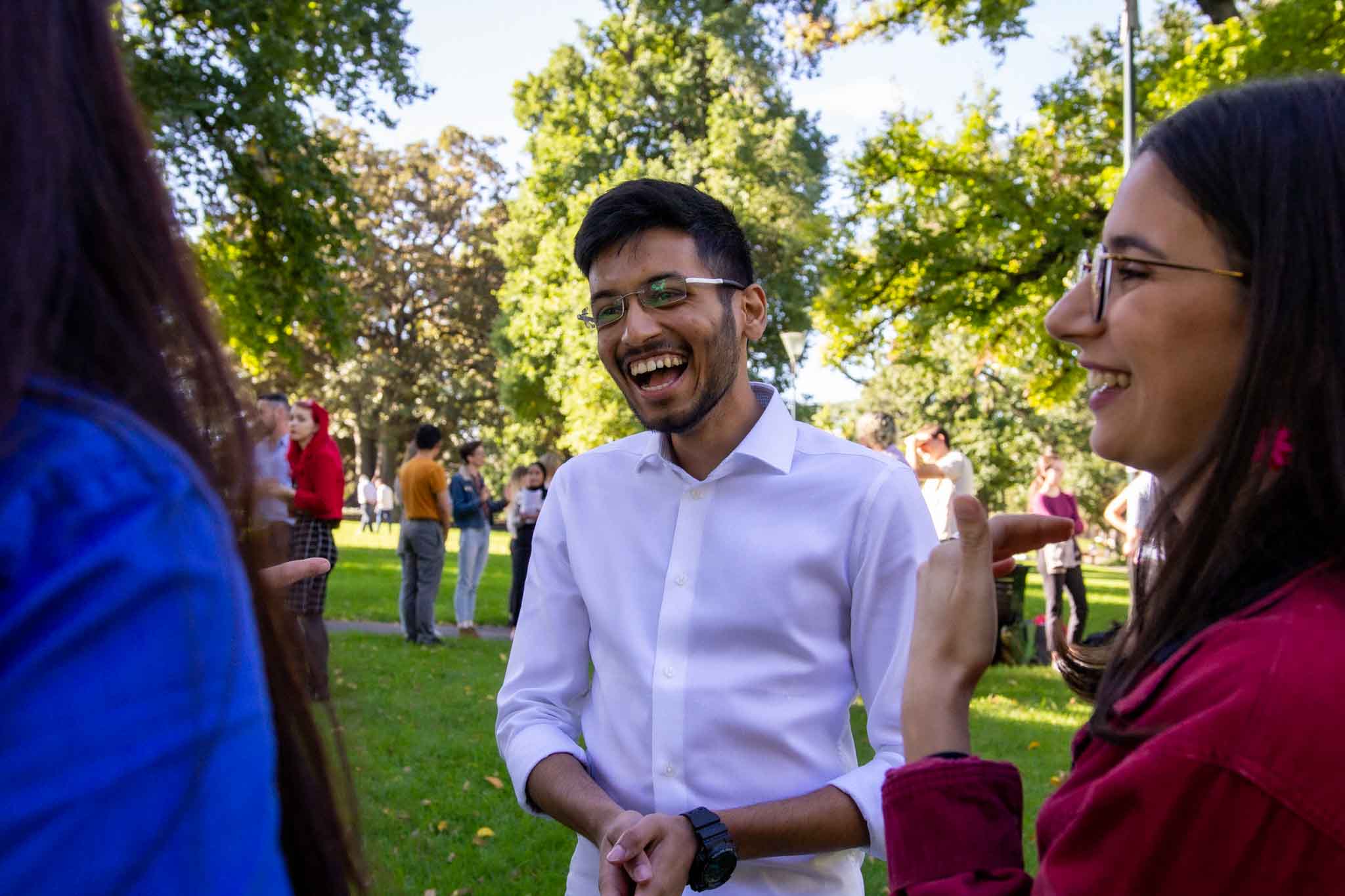
Do:
-
Use plain English or easy English guides and avoid jargon.
-
If there is an interpreter present, speak to the young person you are communicating with, not to the interpreter.
-
Use size 12 font as a minimum where possible in emails and documents. Larger font should be used for slides.
-
Speak clearly by slowing down to a conversational pace, pausing between phrases and thoughts.
Don’t:
-
Speak to young people as if they are young children and infantilise them (avoid using the term ‘kids’).
-
Speak over the young person.
-
Assume the young person prefers one form of communication.
-
Try too hard – young people can usually tell when you’re not being genuine.
- Australian Research Alliance for Children and Youth (ARACY). (2012). A national plan for child and youth wellbeing, A review of the literature. November 2012.
- Black B., Walsh, L. & Taylor, F. (2011). Young people on the margins: What works in youth participation. Youth Studies Australia, 30 (1);
- Boese, M. (2010). From participation to leadership. Evaluation of the Community Service Leadership Program, Brotherhood of St Laurence.
- Broadbent, R. and Papadopoulos, T. (2010). Government, Schools, Young People and Communities in Partnership. Youth Studies Australia, 20(3), 52-60.
- Burns, J., Phillippa, C., Blanchard, M., De-Freitas, N., and Lloyd, S. (2008). Preventing youth disengagement and promoting engagement. ARACY.
- CISCO. (2008). Equipping Every Learner for the 21st Century: A White Paper.
- Collin, P. (2008). Young People Imagining a New Democracy: Literature Review. The Whitlam Institute within the University of Western Sydney.
- Du Plessis, K. and Corney, T. (2011). Trust, respect and friendship: The key attributes of significant others in the lives of young working men. Youth Studies Australia, 30(1), 17-26.
- Easthope, G. and White, R. (2008). Health and wellbeing: how do young people see these concepts?. Youth Studies Australia, 25(1), 42 – 49.
- Hagen, P., Collin, P., Metcalf, A., Nicholas, M., Rahilly, K., Swainston, N. (2012). Participatory Design of Evidence-based Online Youth Mental Health Promotion, Intervention and Treatment. Young and Well CRC.
- Harris, A., Wyn, J. and Younes, S. (2009). Beyond apathetic or activist youth: 'Ordinary' young people and contemporary forms of participation. Young18(1): 9–32.
- Headspace. (2021). The advantages of hiring young employees. https://headspace.org.au/professionals-and-educators/employers/mental-health-at-work/the-advantages-of-hiring-young-employees/
- Innovation Centre for Community and Youth Development. (2005). Reflect and Improve: A Tool Kit for Engaging Youth and Adults as Partners in Program Evaluation.
- Kaufman , L. R. (2011). Community Youth Mapping: A Tool for Youth Participation and Program Design. US:Educational Quality Improvement Program 3 (EQUIP3).
- Kellet, M. (2011). Engaing with Children and Young People. Centre for Children and Young People, Southern Cross University.
- MacCallum, J., Palmer, D., Wright, P., Cumming-Potvin, W., Northcote, J., Brooker, M., Tero, C. (2006). Community building through intergenerational exchange programs. Australian Government Department of Families, Community Services and Indigenous Affairs (FaCSIA).
- Nabben, R. and Hill, R. (2004). Engaging with Young People, Local Government in Action.
